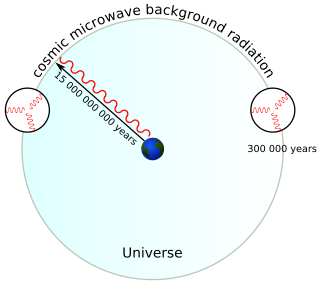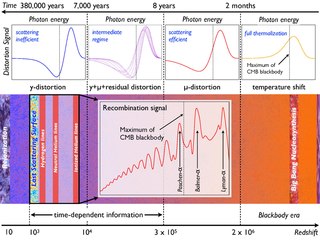Particle physics is the study of the interactions of elementary particles at high energies, whilst physical cosmology studies the universe as a single physical entity. The interface between these two fields is sometimes referred to as particle cosmology. Particle physics must be taken into account in cosmological models of the early universe, when the average energy density was very high. The processes of particle pair production, scattering and decay influence the cosmology.
As a rough approximation, a particle scattering or decay process is important at a particular cosmological epoch if its time scale is shorter than or similar to the time scale of the universe's expansion. The latter quantity is  where
where  is the time-dependent Hubble parameter. This is roughly equal to the age of the universe at that time.
is the time-dependent Hubble parameter. This is roughly equal to the age of the universe at that time.
For example, the pion has a mean lifetime to decay of about 26 nanoseconds. This means that particle physics processes involving pion decay can be neglected until roughly that much time has passed since the Big Bang.
Cosmological observations of phenomena such as the cosmic microwave background and the cosmic abundance of elements, together with the predictions of the Standard Model of particle physics, place constraints on the physical conditions in the early universe. The success of the Standard Model at explaining these observations support its validity under conditions beyond those which can be produced in a laboratory. Conversely, phenomena discovered through cosmological observations, such as dark matter and baryon asymmetry, suggest the presence of physics that goes beyond the Standard Model.

The Big Bang theory describes how the universe expanded from an initial state of high density and temperature. It is the prevailing cosmological model explaining the evolution of the observable universe from the earliest known periods through its subsequent large-scale form. The model offers a comprehensive explanation for a broad range of observed phenomena, including the abundance of light elements, the cosmic microwave background (CMB) radiation, and large-scale structure.

Physical cosmology is a branch of cosmology concerned with the study of cosmological models. A cosmological model, or simply cosmology, provides a description of the largest-scale structures and dynamics of the universe and allows study of fundamental questions about its origin, structure, evolution, and ultimate fate. Cosmology as a science originated with the Copernican principle, which implies that celestial bodies obey identical physical laws to those on Earth, and Newtonian mechanics, which first allowed those physical laws to be understood.

In physical cosmology, cosmic inflation, cosmological inflation, or just inflation, is a theory of exponential expansion of space in the early universe. The inflationary epoch lasted from 10−36 seconds after the conjectured Big Bang singularity to some time between 10−33 and 10−32 seconds after the singularity. Following the inflationary period, the universe continued to expand, but at a slower rate. The acceleration of this expansion due to dark energy began after the universe was already over 7.7 billion years old.

In Big Bang cosmology the cosmic microwave background is electromagnetic radiation that is a remnant from an early stage of the universe, also known as "relic radiation". The CMB is faint cosmic background radiation filling all space. It is an important source of data on the early universe because it is the oldest electromagnetic radiation in the universe, dating to the epoch of recombination when the first atoms were formed. With a traditional optical telescope, the space between stars and galaxies is completely dark. However, a sufficiently sensitive radio telescope shows a faint background noise, or glow, almost uniform, that is not associated with any star, galaxy, or other object. This glow is strongest in the microwave region of the radio spectrum. The accidental discovery of the CMB in 1965 by American radio astronomers Arno Penzias and Robert Wilson was the culmination of work initiated in the 1940s, and earned the discoverers the 1978 Nobel Prize in Physics.

In physical cosmology, Big Bang nucleosynthesis is the production of nuclei other than those of the lightest isotope of hydrogen during the early phases of the Universe. Primordial nucleosynthesis is believed by most cosmologists to have taken place in the interval from roughly 10 seconds to 20 minutes after the Big Bang, and is calculated to be responsible for the formation of most of the universe's helium as the isotope helium-4 (4He), along with small amounts of the hydrogen isotope deuterium, the helium isotope helium-3 (3He), and a very small amount of the lithium isotope lithium-7 (7Li). In addition to these stable nuclei, two unstable or radioactive isotopes were also produced: the heavy hydrogen isotope tritium ; and the beryllium isotope beryllium-7 (7Be); but these unstable isotopes later decayed into 3He and 7Li, respectively, as above.

A non-standard cosmology is any physical cosmological model of the universe that was, or still is, proposed as an alternative to the then-current standard model of cosmology. The term non-standard is applied to any theory that does not conform to the scientific consensus. Because the term depends on the prevailing consensus, the meaning of the term changes over time. For example, hot dark matter would not have been considered non-standard in 1990, but would be in 2010. Conversely, a non-zero cosmological constant resulting in an accelerating universe would have been considered non-standard in 1990, but is part of the standard cosmology in 2010.

Plasma cosmology is a non-standard cosmology whose central postulate is that the dynamics of ionized gases and plasmas play important, if not dominant, roles in the physics of the universe beyond the Solar System. In contrast, the current observations and models of cosmologists and astrophysicists explain the formation, development, and evolution of astronomical bodies and large-scale structures in the universe as influenced by gravity and baryonic physics.

In physical cosmology, baryogenesis is the physical process that is hypothesized to have taken place during the early universe to produce baryonic asymmetry, i.e. the imbalance of matter (baryons) and antimatter (antibaryons) in the observed universe.

The horizon problem is a cosmological fine-tuning problem within the Big Bang model of the universe. It arises due to the difficulty in explaining the observed homogeneity of causally disconnected regions of space in the absence of a mechanism that sets the same initial conditions everywhere. It was first pointed out by Wolfgang Rindler in 1956.

The ΛCDM or Lambda-CDM model is a parameterization of the Big Bang cosmological model in which the universe contains three major components: first, a cosmological constant denoted by Lambda associated with dark energy; second, the postulated cold dark matter ; and third, ordinary matter. It is frequently referred to as the standard model of Big Bang cosmology because it is the simplest model that provides a reasonably good account of the following properties of the cosmos:

In physical cosmology, structure formation is the formation of galaxies, galaxy clusters and larger structures from small early density fluctuations. The universe, as is now known from observations of the cosmic microwave background radiation, began in a hot, dense, nearly uniform state approximately 13.8 billion years ago. However, looking at the night sky today, structures on all scales can be seen, from stars and planets to galaxies. On even larger scales, galaxy clusters and sheet-like structures of galaxies are separated by enormous voids containing few galaxies. Structure formation attempts to model how these structures were formed by gravitational instability of small early ripples in spacetime density or another emergence.

In physical cosmology, the baryon asymmetry problem, also known as the matter asymmetry problem or the matter–antimatter asymmetry problem, is the observed imbalance in baryonic matter and antibaryonic matter in the observable universe. Neither the standard model of particle physics, nor the theory of general relativity provides a known explanation for why this should be so, and it is a natural assumption that the universe is neutral with all conserved charges. The Big Bang should have produced equal amounts of matter and antimatter. Since this does not seem to have been the case, it is likely some physical laws must have acted differently or did not exist for matter and antimatter. Several competing hypotheses exist to explain the imbalance of matter and antimatter that resulted in baryogenesis. However, there is as of yet no consensus theory to explain the phenomenon, which has been described as "one of the great mysteries in physics".

The cosmic neutrino background is the universe's background particle radiation composed of neutrinos. They are sometimes known as relic neutrinos.
A cosmological horizon is a measure of the distance from which one could possibly retrieve information. This observable constraint is due to various properties of general relativity, the expanding universe, and the physics of Big Bang cosmology. Cosmological horizons set the size and scale of the observable universe. This article explains a number of these horizons.

The Milne model was a special-relativistic cosmological model proposed by Edward Arthur Milne in 1935. It is mathematically equivalent to a special case of the FLRW model in the limit of zero energy density and it obeys the cosmological principle. The Milne model is also similar to Rindler space, a simple re-parameterization of flat Minkowski space.
Cosmic time, or cosmological time, is the time coordinate commonly used in the Big Bang models of physical cosmology. Such time coordinate may be defined for a homogeneous, expanding universe so that the universe has the same density everywhere at each moment in time. The clocks measuring cosmic time should move along the Hubble flow.

In particle physics, CP violation is a violation of CP-symmetry : the combination of C-symmetry and P-symmetry. CP-symmetry states that the laws of physics should be the same if a particle is interchanged with its antiparticle (C-symmetry) while its spatial coordinates are inverted. The discovery of CP violation in 1964 in the decays of neutral kaons resulted in the Nobel Prize in Physics in 1980 for its discoverers James Cronin and Val Fitch.

The chronology of the universe describes the history and future of the universe according to Big Bang cosmology.
In Big Bang cosmology, neutrino decoupling was the epoch at which neutrinos ceased interacting with other types of matter, and thereby ceased influencing the dynamics of the universe at early times. Prior to decoupling, neutrinos were in thermal equilibrium with protons, neutrons and electrons, which was maintained through the weak interaction. Decoupling occurred approximately at the time when the rate of those weak interactions was slower than the rate of expansion of the universe. Alternatively, it was the time when the time scale for weak interactions became greater than the age of the universe at that time. Neutrino decoupling took place approximately one second after the Big Bang, when the temperature of the universe was approximately 10 billion kelvin, or 1 MeV.

CMB spectral distortions are tiny departures of the average cosmic microwave background (CMB) frequency spectrum from the predictions given by a perfect black body. They can be produced by a number of standard and non-standard processes occurring at the early stages of cosmic history, and therefore allow us to probe the standard picture of cosmology. Importantly, the CMB frequency spectrum and its distortions should not be confused with the CMB anisotropy power spectrum, which relates to spatial fluctuations of the CMB temperature in different directions of the sky.









